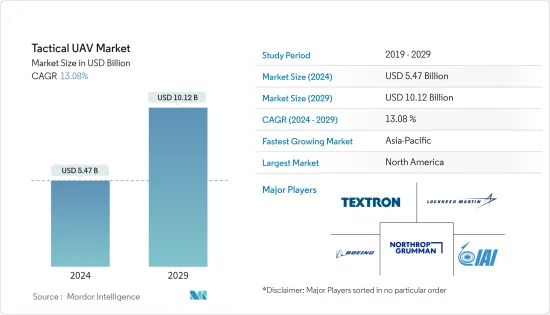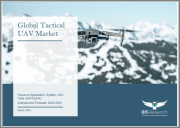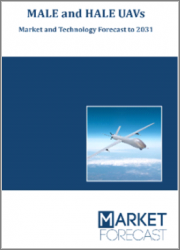
|
시장보고서
상품코드
1536949
전술 UAV - 시장 점유율 분석, 산업 동향 및 통계, 성장 예측(2024-2029년)Tactical UAV - Market Share Analysis, Industry Trends & Statistics, Growth Forecasts (2024 - 2029) |
||||||
전술 UAV 시장 규모는 2024년 54억 7,000만 달러로 추정되며, 2029년에는 101억 2,000만 달러에 달할 것으로 예상되며, 예측 기간(2024-2029년) 동안 13.08%의 CAGR로 성장할 것으로 예상됩니다.

실시간 정보는 전투원, 지휘관, 부대가 중요한 군사 임무를 성공적으로 수행하기 위한 가장 강력한 무기가 됩니다. 따라서 군대는 우수한 전술 정보, 감시 및 정찰을 통해 위협에 대한 대응을 조정하고 있습니다. 이 때문에 전 세계 군대에서 전술 UAV에 대한 수요가 증가하고 있습니다.
일부 UAV 제조업체는 전기 광학 센서 및 적외선 센서의 고급 페이로드를 갖춘 차세대 전술 UAV를 개발하고 있으며, OEM은 정찰, 감시, 공격 임무 등 다양한 임무를 수행 할 수있는 다중 역할 UAV 플랫폼에 큰 기회를 남겨두고 있습니다. 다양한 임무를 수행할 수 있습니다. 재난 대응 및 인프라 점검과 같은 민간용 UAV에 대한 수요도 증가하고 있으며, 이는 UAV 제조업체의 수익원이 될 수 있습니다.
전술용 무인항공기 도입의 주요 과제는 규제 제약과 공역 통합입니다. 비행 고도 및 공역 접근 제한과 같은 규제 장벽은 일부 국가에서 전술 UAV의 채택을 방해할 수 있습니다.
UAV의 자율성과 지능 능력은 지속적으로 발전하고 있습니다. 전술 UAV의 자율성은 점점 더 향상되어 인간의 개입을 최소화하면서 복잡한 임무를 수행할 수 있게 되었습니다. 이러한 자율 기술의 발전은 보다 효율적이고 효과적인 군사 작전의 필요성과 인공지능 및 센서 기술의 발전으로 인해 이루어지고 있습니다. 즉각적인 배치가 가능하고 열악한 환경에서도 활동할 수 있는 더 작고 민첩한 UAV에 대한 수요가 증가하고 있습니다.
전술 무인항공기(UAV) 시장 동향
예측 기간 동안 군사 부문이 시장을 주도할 것으로 예상
군사적 용도가 점점 더 다양해지고 가장 중요한 군사적 용도 중 일부에서 매우 효과적이고 객관적인 감시 및 정찰이 요구됨에 따라 시장의 군사적 용도 부문에서 가장 높은 수요를 보이고 있습니다. 세계 주요 군사 강대국 간의 지속적인 분쟁으로 인해 전 세계적으로 불안감이 고조되고 있으며, 일부 군대는 적의 모든 적대 행위에 성공적으로 대응하기 위해 전술 UAV 함대를 확장하는 데 주력하고 있습니다.
전술 무인항공기는 국경에서 중단 없는 감시를 보장하는 데 필수적입니다. 다양한 용도로 인해 전술 UAV에 대한 수요는 지난 10년 동안 몇 배나 증가했습니다. 따라서 전 세계 군대의 증가하는 수요를 충족시키기 위해 여러 조달이 진행 중이거나 배치되었습니다. 예를 들어, 스위스는 2022년 5월 이스라엘로부터 엘비트시스템즈의 에르메스 900 무인항공기 시스템 6대 중 첫 두 대를 받았습니다. 스위스는 2023년 말까지 다른 4대의 드론을 받을 예정입니다.
국경 보안과 항공 감시는 이러한 드론의 또 다른 중요한 응용 분야로 전술 드론에 대한 수요를 주도하고 있습니다. 예를 들어, 2022년 3월 사우디의 Intra Defence Technologies는 정보, 감시 및 정찰 임무에 최적화 된 디자인의 Samoomtactical MALE UAV를 발표했습니다. 사우디 군대는 이 드론의 첫 번째 고객이 될 것으로 기대했습니다.
2022년 10월, 인도 육군은 북부 국경 감시 시스템을 강화하기 위해 긴급 조달을 통해 750대의 원격조종 항공기(드론)와 액세서리 세트를 신속하게 조달하는 입찰을 실시했습니다. 이러한 시장 개척은 향후 몇 년 동안 군사 분야의 전술 무인항공기 시장을 주도할 것으로 예상됩니다.
예측 기간 동안 아시아태평양이 가장 높은 성장률을 기록할 것으로 예상
아시아태평양은 R&D 활동의 증가와 이 지역 국가들의 조달 증가로 인해 예측 기간 동안 가장 높은 성장과 수요를 기록할 것으로 예상됩니다. 주요 전술적 용도로 드론 구매가 증가함에 따라 이러한 드론 개발에 참여하는 다양한 국가의 수요가 증가하고 있습니다. 해군 부대가 사용하는 효과적인 국경 순찰 및 해상 순찰에 대한 강조가 증가함에 따라 이러한 응용 분야에서 전술 드론에 대한 수요가 증가하고 있습니다.
아시아태평양은 급속한 경제 성장과 지정학적 긴장으로 인해 각국 정부는 UAV를 포함한 첨단 군사 기술에 투자하고 있습니다. 중국, 인도, 일본, 대만, 한국과 같은 국가들은 고유한 UAV 능력 개발에 큰 진전을 이루었습니다. 현재 진행 중인 영토 분쟁과 안보 이슈는 아시아태평양의 ISR 목적의 UAV 수요를 더욱 부추기고 있습니다.
2022년 6월, 대만 육군은 합동 대대의 정찰 능력을 향상시키기 위해 단거리 전술 무인항공기 50대를 구매했습니다. 2020년에서 2023년까지 7억 7,998만 대만달러(2,650만 달러)의 예산을 편성하여 2022년에 14대, 2023년에 36대의 UAV를 구매했으며, 2022년 1월 일본은 노스롭그루먼의 RQ-4 월드호크 드론을 5억 2,800만 달러(5억 2,000만 달러)에 조달할 계획을 재개했습니다. RQ-4 월드 호크는 일본 미사와 기지에 배치되는 고고도 정찰기로, 일본 미사와 기지에 배치될 예정입니다.
현재 인도 국방부는 ISR 능력을 강화하고 군사 작전의 효율성을 높이기 위해 첨단 UAV를 조달하고 있으며, 2023년 12월 존넷 테크놀러지는 인도 육군으로부터 국경 감시를 위한 주력 전술 UAV '존넷 JF-2'를 수주했습니다. Johnnette JF-2는 인도 최초의 충돌 방지 드론으로, 정찰 및 정찰 활동을 위해 설계된 손타식 고정익 전술 UAV로, 고해상도 주간 카메라와 적외선 카메라가 장착되어 있으며, UAV는 또한 추락 방지 항공전자 베이, 안티 재밍 및 안티 스푸핑, 안티 재밍 및 안티 스푸핑 기능을 갖추고 있습니다. 재밍 및 스푸핑 방지 기능을 갖추고 있어 군에 이상적인 솔루션이 될 수 있습니다. 인도의 전술 UAV는 현재 항속거리가 매우 짧은 전술 부대를 지원하기 위해 대규모 개발이 진행되고 있습니다.
전술 무인항공기(UAV) 산업 개요
전술용 UAV 시장은 여러 공급업체와 전술 및 ISR 임무에 사용할 수 있는 UAV로 세분화되어 있습니다. 시장의 주요 업체로는 보잉, 록히드마틴, 노스롭그루먼, 이스라엘 항공우주 산업, 텍스트론 등이 있습니다. 이들 업체들은 모두 국제적인 대기업으로, 다양한 전략을 통해 존재감과 제품 포트폴리오를 확장하기 위해 노력하고 있습니다.
일부 UAV 제조업체는 전기 광학 또는 적외선 센서의 고급 페이로드와 라이브 비디오 및 기타 귀중한 정보를 전송하여 부대에 힘을 실어줄 수 있는 기능을 갖춘 새로운 전술 UAV를 개발하고 있습니다. 예를 들어, 이스라엘의 Elbit Systems는 2024년 2월 Hermes 650 Spark UAV를 발표했습니다. 이 UAV는 8개의 모듈식 격납고와 날개에 6개의 하드포인트가 장착된 중-고고도 장기 내구성(MALE) UAV다. 이 다중 페이로드 기능은 고품질 전기 광학 센서, 레이더, 신호 정보 장비 및 고급 페이로드를 통합합니다.
전술 무인항공기 국산화에 대한 관심이 높아짐에 따라 새로운 기업이 시장에 진입할 것으로 예상됩니다. 지난 몇 년 동안 몇몇 소규모 업체들이 지속적으로 시장에서 존재감을 높이고 있습니다. 이들 기업은 기술이 성숙하고 비행 시간이 증가함에 따라 군사 및 비군사 고객을 포함한 현지 사용자를 위해 만들어진 기술과 역량을 구축하고 있으며 향후 중요한 역할을 할 것으로 예상됩니다. 예를 들어, 2023년 2월 인도 칼리야니 그룹(Kalyani Group)은 마하라슈트라 MSME 디펜스 엑스포(Maharashtra MSME Defense Expo)에서 새로운 단거리 전술 UAV를 선보이며 무인항공기(UAV) 분야로의 첫 진출을 선언했습니다.
기타 혜택
- 엑셀 형식의 시장 예측(ME) 시트
- 3개월간의 애널리스트 지원
목차
제1장 소개
- 조사 가정
- 조사 범위
제2장 조사 방법
제3장 주요 요약
제4장 시장 역학
- 시장 개요
- 시장 성장 촉진요인
- 시장 성장 억제요인
- 업계의 매력 - Porter's Five Forces 분석
- 구매자/소비자의 협상력
- 공급 기업의 교섭력
- 신규 참여업체의 위협
- 대체품의 위협
- 경쟁 기업 간의 경쟁 강도
제5장 시장 세분화
- 용도별
- 군용
- 법집행
- 기타 용도
- 지역별
- 북미
- 미국
- 캐나다
- 유럽
- 영국
- 프랑스
- 독일
- 기타 유럽
- 아시아태평양
- 중국
- 인도
- 일본
- 한국
- 기타 아시아태평양
- 라틴아메리카
- 브라질
- 기타 라틴아메리카
- 중동 및 아프리카
- 아랍에미리트
- 사우디아라비아
- 이스라엘
- 터키
- 기타 중동 및 아프리카
- 북미
제6장 경쟁 상황
- 벤더 시장 점유율
- 기업 개요
- SZ DJI Technology Co. Ltd.
- Aeronautics Ltd
- General Atomics
- BAYKAR TECH
- BlueBird Aero Systems
- Elbit Systems Ltd.
- AeroVironment, Inc.
- Israel Aerospace Industries Ltd.
- The Boeing Company
- Safran
- Leonardo S.p.A.
- Textron Inc.
- Lockheed Martin Corporation
- Northrop Grumman Corporation
- Saab AB
제7장 시장 기회와 향후 동향
ksm 24.09.04The Tactical UAV Market size is estimated at USD 5.47 billion in 2024, and is expected to reach USD 10.12 billion by 2029, growing at a CAGR of 13.08% during the forecast period (2024-2029).

To succeed in critical military missions, real-time information can be the most powerful weapon for warfighters, commanders, and troops to protect themselves. Hence, the armed forces are tailoring their response to the threat using superior tactical intelligence, surveillance, and reconnaissance. This is generating the demand for tactical UAVs from the armed forces worldwide.
Several UAV manufacturers are developing newer generation tactical UAVs with an advanced payload of electro-optical or infrared sensors, with capabilities to transmit live video and other invaluable information that can empower troops. Major opportunities for OEMs remain in multi-role UAV platforms capable of performing a variety of missions, including reconnaissance, surveillance, and strike missions. There is a growing demand for UAVs for civilian applications, such as disaster response and infrastructure inspection, which can open revenue streams for UAV manufacturers.
The primary challenge for tactical UAV adoption is regulatory constraints and airspace integration. Regulatory hurdles, such as restrictions on flight altitudes and airspace access, can hinder the adoption of tactical UAVs in a few countries.
There is continuous advancement in the autonomy and intelligence capabilities of UAVs. Tactical UAVs are becoming increasingly autonomous and able to perform complex missions with minimal human intervention. This advancement in autonomous technology is driven by the need for more efficient and effective military operations and advancements in artificial intelligence and sensor technologies. There is a shift in demand toward smaller, more agile UAVs that can be deployed instantly and can operate in challenging environments.
Tactical Unmanned Aerial Vehicle (UAV) Market Trends
The Military Segment is Anticipated to Lead the Market During the Forecast Period
The increasingly diverse military applications and the requirement for highly effective and objective surveillance and reconnaissance for some of the most critical military applications are driving the highest demand from the military applications segment of the market. With increasing global unrest due to the ongoing conflicts between major global military superpowers, several militaries are focusing on expanding the fleets of their tactical UAVs to counter any adversary actions from enemies successfully.
Tactical UAVs are critical to ensure uninterrupted surveillance at the borders. Due to its diverse application profile, the demand for tactical UAVs has witnessed a multifold increase during the last decade. Hence, several procurements are underway or being placed to cater to the increased demand from global military forces. For instance, in May 2022, Switzerland received the first two of six Elbit Systems' Hermes 900 unmanned aerial systems from Israel. The country would receive four other drones by the end of 2023.
Border patrol and air surveillance are other critical areas of application for these drones, driving the demand for tactical drones. For instance, in March 2022, Saudi Arabia's Intra DefenceTechnologies unveiled its Samoomtactical MALE UAV, with the design to be optimized for intelligence, surveillance, and reconnaissance tasks. The Saudi Armed Forces anticipated becoming the first customer of the drone.
In October 2022, to bolster the surveillance system on the northern border, the Indian Army floated tenders to procure 750 remotely piloted aerial vehicles or drones along with complete accessories through a fast-track procedure under emergency procurement. Such developments are expected to drive the market for tactical UAVs in the military sector in the coming years.
Asia-Pacific will Experience the Highest Growth During the Forecast Period
Asia-Pacific is expected to register the highest growth and demand during the forecast period due to increasing R&D activities and increasing procurements by countries in the region. The increased purchase of drones for major tactical applications has increased the demand from various countries involved in developing these drones. The rising emphasis on effective border patrol and maritime patrol used by naval forces has increased the demand for tactical drones in these applications.
As Asia-Pacific has been witnessing rapid economic growth and geopolitical tensions, governments are investing in advanced military technologies, including UAVs. Countries like China, India, Japan, Taiwan, and South Korea have made significant strides in developing indigenous UAV capabilities. Ongoing territorial disputes and security challenges have further fueled the demand for UAVs for ISR purposes in Asia-Pacific.
In June 2022, the Taiwan Army purchased 50 short-range tactical UAVs to improve joint battalion reconnaissance capabilities. The Army prepared a budget of TWD 779.98 million (USD 26.5 million) from 2020 to 2023 to acquire 14 UAVs in 2022 and 36 sets in 2023. In January 2022, Japan resumed its plan to procure Northrop Grumman's RQ-4 Global Hawk Drone in a deal worth USD 528 million. The RQ-4 Global Hawk is a High-Altitude surveillance drone to be stationed at the ASDF Misawa Air Base in Japan.
Currently, the Indian Defense Ministry is procuring high-tech UAVs to strengthen its ISR capabilities and improve the effectiveness of its military operations. In December 2023, Johnnette Technologies secured a contract from the Indian Army for its flagship tactical UAV "Johnnette JF-2" for border surveillance. The Johnnette JF-2 is India's first crash-resistant drone. The Johnnette JF-2 is a hand-launched fixed-wing tactical UAV designed for surveillance and reconnaissance operations. The UAV is equipped with a high-definition day camera and a thermal imaging camera. The UAV also features a crash-proof avionics bay and anti-jamming and anti-spoofing capabilities, making it an ideal solution for military forces. India's tactical UAVs are currently being developed on a huge scale to support tactical units with very short ranges.
Tactical Unmanned Aerial Vehicle (UAV) Industry Overview
The market for tactical UAVs is fragmented, with several providers and UAVs that can be used for tactical and ISR missions. The key players in the market are The Boeing Company, Lockheed Martin Corporation, Northrop Grumman Corporation, Israel Aerospace Industries Ltd, and Textron Inc. These players are all major international companies trying to expand their presence and product portfolio by adopting different strategies.
Several UAV manufacturers are developing newer tactical UAVs with advanced payloads of electro-optical or infrared sensors and the capability to transmit live video and other invaluable information that can empower troops. For instance, in February 2024, Israel's Elbit Systems unveiled the Hermes 650 Spark UAV. It delivers medium-altitude long-endurance (MALE) UAV capabilities and features eight modular storage stations and six hardpoints on the wings. This multi-payload capability integrates high-quality electro-optical sensors, radar, signals intelligence equipment, and advanced payloads.
The growing focus on the indigenous development of tactical UAVs is anticipated to help the advent of new players in the market. In recent years, several smaller players have constantly grown their market presence. They are expected to play a critical role in the future as their technology matures and gains flight hours while building technologies and capabilities made for their local users, including both military and non-military customers. For instance, in February 2023, Kalyani Group (India) unveiled its first foray into the unmanned aerial vehicle (UAV) sector at the Maharashtra MSME Defence Expo with the showcase of a new short-range tactical UAV.
Additional Benefits:
- The market estimate (ME) sheet in Excel format
- 3 months of analyst support
TABLE OF CONTENTS
1 INTRODUCTION
- 1.1 Study Assumptions
- 1.2 Scope of the Study
2 RESEARCH METHODOLOGY
3 EXECUTIVE SUMMARY
4 MARKET DYNAMICS
- 4.1 Market Overview
- 4.2 Market Drivers
- 4.3 Market Restraints
- 4.4 Industry Attractiveness - Porter's Five Forces Analysis
- 4.4.1 Bargaining Power of Buyers/Consumers
- 4.4.2 Bargaining Power of Suppliers
- 4.4.3 Threat of New Entrants
- 4.4.4 Threat of Substitute Products
- 4.4.5 Intensity of Competitive Rivalry
5 MARKET SEGMENTATION
- 5.1 By Application
- 5.1.1 Military
- 5.1.2 Law Enforcement
- 5.1.3 Other Applications
- 5.2 Geography
- 5.2.1 North America
- 5.2.1.1 United States
- 5.2.1.2 Canada
- 5.2.2 Europe
- 5.2.2.1 United Kingdom
- 5.2.2.2 France
- 5.2.2.3 Germany
- 5.2.2.4 Rest of Europe
- 5.2.3 Asia-Pacific
- 5.2.3.1 China
- 5.2.3.2 India
- 5.2.3.3 Japan
- 5.2.3.4 South Korea
- 5.2.3.5 Rest of Asia-Pacific
- 5.2.4 Latin America
- 5.2.4.1 Brazil
- 5.2.4.2 Rest of Latin America
- 5.2.5 Middle East and Africa
- 5.2.5.1 United Arab Emirates
- 5.2.5.2 Saudi Arabia
- 5.2.5.3 Israel
- 5.2.5.4 Turkey
- 5.2.5.5 Rest of Middle East and Africa
- 5.2.1 North America
6 COMPETITIVE LANDSCAPE
- 6.1 Vendor Market Share
- 6.2 Company Profiles
- 6.2.1 SZ DJI Technology Co. Ltd.
- 6.2.2 Aeronautics Ltd
- 6.2.3 General Atomics
- 6.2.4 BAYKAR TECH
- 6.2.5 BlueBird Aero Systems
- 6.2.6 Elbit Systems Ltd.
- 6.2.7 AeroVironment, Inc.
- 6.2.8 Israel Aerospace Industries Ltd.
- 6.2.9 The Boeing Company
- 6.2.10 Safran
- 6.2.11 Leonardo S.p.A.
- 6.2.12 Textron Inc.
- 6.2.13 Lockheed Martin Corporation
- 6.2.14 Northrop Grumman Corporation
- 6.2.15 Saab AB













